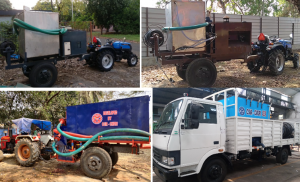New Mechanized Scavenging System to Tackle Diverse Sewerage Chokages
Council of Scientific and Industrial Research (CSIR)’s Durgapur-based constituent laboratory CSIR-Central Mechanical Engineering Research Institute (CMERI) has developed a mechanized scavenging system, which was initiated after intensive studies of the diverse nature of Indian sewerage systems and the manner of its chokages. The technology is modular in design to ensure customised deployment strategies as per situational requirements.
Mechanical Engineering Research Institute (CMERI) has developed a mechanized scavenging system, which was initiated after intensive studies of the diverse nature of Indian sewerage systems and the manner of its chokages. The technology is modular in design to ensure customised deployment strategies as per situational requirements.
This System also focuses upon sustainable usage of resources as the system sucks in slurry water from the choked sewerage systems and after adequate filtration, redirects the same for clearing of chokages using a self-propelling nozzle. As per CSIR-CMERI, this technology provides in-situ option for mechanized scavenging as well as purification of water.
Technology design is such that the water filtration mechanism can be modified as per the customised requirements with the ability to change the filter media. The vehicle-mounted filtration units will be able to augment and use water from the surface drain and flooded areas, and purify it into water suitable for agricultural, household, and drinking water usage.
Also Read : Innovations and Startups Must Be Discovered and Supported: Dr. Jitendra Singh
Drinking water scarcity prevalent in flood-affected regions can be solved to a certain extent by providing instantaneous and in-situ water purification solutions at ease. This technology provides a consolidated solution to clear drainage chokages in flood-affected regions, which will help in providing an outlet for flood stagnated water, as well as provide water purification solutions in flood disaster zones, say Dr. Harish Hirani, director, CSIR-CMERI.
There are three variants of this mechanized scavenging system developed which includes drain/sewer cleaning system for narrow-lanes and small dwellings (within 500 people), the scavenging system for residential complexes, townships and gram panchayats (within 1000-2000 people), and system for urban and local bodies (within 2000-5000 people). These three modules for different population densities with different features to make the machine more cost economic.
The utilisation of the slurry water for the jetting operation is one of the novelties, which reduces the wastage of freshwater. A self-propelled post-cleaning inspection system is also one of unique features of the machine. The Proto development cost of module-1 is estimated at around Rs. 05 lakhs, module-2 costs around Rs. 08 lakhs and the cost of the module-3 is Rs. 25 lakhs, excluding GST, CSIR-CMERI statement said.
The technology has already undergone four field trials at the premises of the National Institute of Technology, Durgapur, National Power Training Institute of India, Durgapur, Durgapur Steel Plant (DSP), and Damodar Valley Corporation-Durgapur Thermal Power Station for the assessment of functionality and effectiveness. The feedback received from the user-end after the field trials have been encouraging as it has been able to effectively and efficiently remove complicated chokages from sewerage systems and was found to be suitable for most situations.
“The field trials have also brought in Constructive Suggestions for improving the Scope and Versatility of the Technology in further complicated situations for future usage. Once, the System achieves a certain degree of diversification in terms of versatility, it will be dedicated to the Nation to serve the society and give a final thrust to the Swachch Bharat Abhiyan of the Government of India as well as complete decimation of manual scavenging from India,” said Dr Hirani.
The newly developed scavenging system would help the manual scavengers to skill themselves on the latest technological advancements in sewerage maintenance systems as well as enhance their efficiency, performance and safeguard them against intrusive pathogens. This would remove the Indignity from the profession of scavenging and help convert their practice to be more safe and skilful. (Indian Science Wire)
